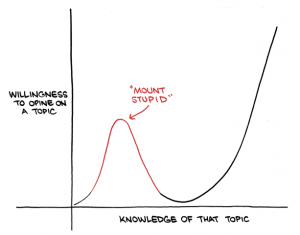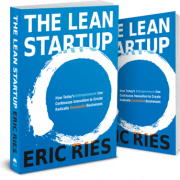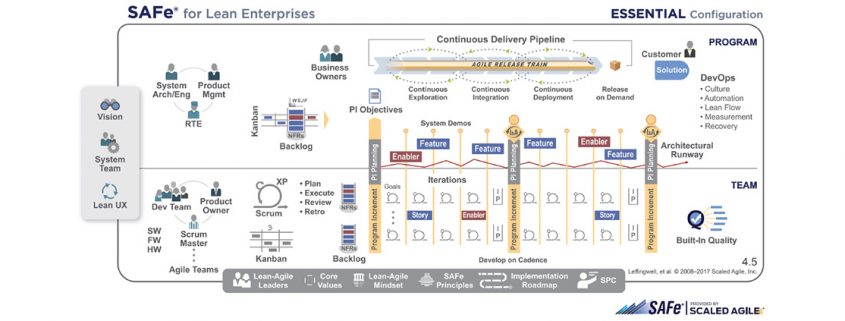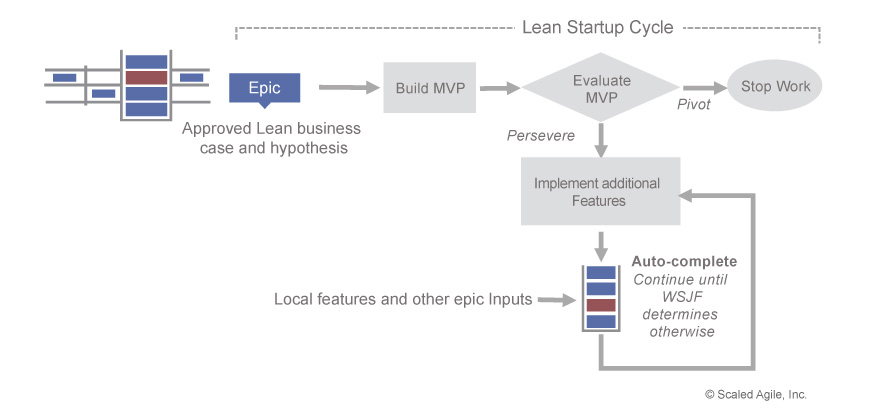Comments on SAFe 4.5: is it all cosmetic?
Recently SAFe 4.5 was released. Of course there is a lot of information from SAI itself on what’s new in SAFe 4.5, so I want won’t cover all changes in detail here but focus on adding some comments on the significance and usefulness of the changes, or lack of it for that matter.
Cosmetic surgery isn’t always a bad thing
 Let me start with something that might feel cosmetic but actually is the most significant improvement in my opinion, namely the fact that the ‘Big Picture’ didn’t get bigger or more complicated this time. From SAFe 3.0 to 4.0 the framework went from three layers to four. In my SAFe courses I sometimes joke that hopefully SAFe 5.0 will not have five layers. I still spend quite some time explaining you should not consider using the Values Stream layer unless it is a very large complex SAFe adoption. While the challenge of coordinating multiple trains in a single Value Stream is of course real, the solution SAFe presents in the Value Stream layer leans rather high towards processes if we consider the Agile Manifesto value Individuals and Interactions over Processes and Tools. In this respect I rather like the most basic coordination mechanism in LeSS: Just Talk. We can come a long way using this mechanism before we actually need to define formal processes in my opinion. It is actually a trap for larger bureaucratic organizations trying to transform to a more agile organization: they have the tendency to model everything in processes instead of telling people to just talk to each other whenever there is something to coordinate.
Let me start with something that might feel cosmetic but actually is the most significant improvement in my opinion, namely the fact that the ‘Big Picture’ didn’t get bigger or more complicated this time. From SAFe 3.0 to 4.0 the framework went from three layers to four. In my SAFe courses I sometimes joke that hopefully SAFe 5.0 will not have five layers. I still spend quite some time explaining you should not consider using the Values Stream layer unless it is a very large complex SAFe adoption. While the challenge of coordinating multiple trains in a single Value Stream is of course real, the solution SAFe presents in the Value Stream layer leans rather high towards processes if we consider the Agile Manifesto value Individuals and Interactions over Processes and Tools. In this respect I rather like the most basic coordination mechanism in LeSS: Just Talk. We can come a long way using this mechanism before we actually need to define formal processes in my opinion. It is actually a trap for larger bureaucratic organizations trying to transform to a more agile organization: they have the tendency to model everything in processes instead of telling people to just talk to each other whenever there is something to coordinate.
So the Big Picture didn’t get any bigger this time. Actually it got a lot cleaner. The most significant change in this regard is the configurability of the Big Picture. SAFe now has four base configurations targeted at a specific context. Each configuration only displays the constructs that are relevant for that configuration, making the big picture a lot easier to read. The four configurations are: Essential SAFe, Portfolio SAFe, Large SAFe, and Full SAFe. Selecting a configuration and watching the Big Picture change accordingly is actually quite fun and insightful.
Second, the Big Picture got a visual make-over making it less cluttered and easier to read. SAI claims they actually added more stuff then they removed so kudos to the visual designer.
Third, the Value Stream layer is renamed to Large Solution. Again, this seems purely cosmetic, but as I said I spend a lot of time explaining to people you don’t need to do everything on the Big Picture just because it is on there. Calling it Large Solution will definitely make it easier to understand you only need a large solution when you have a… large problem.
 Now you might wonder why I spend so much time on cosmetic changes. The reason is the ‘completeness’ of the Big Picture is both a blessing, you click on anything and instantly get tons of information on the topic, and a curse. Organizations have a tendency to want to implement everything on the Big Picture because they think they are supposed to. The overview can also be quite overwhelming at first glance. And it also makes SAFe an easy target for a sometimes rather loud group of agilists, sitting comfortably high on Mount Stupid, shouting down that SAFE is not agile at all, usually while having no more experience than glancing at the Big Picture at scaledagileframework.com. Yeah, I could just ignore those people but unfortunately they tell their tales to customers as well. If you haven’t heard of Mount Stupid, also known as the Dunning-Kruger effect, it is the phenomenon that people who are the most ignorant on a subject are also the ones most eager to share their opinion on it. Sounds familiar?
Now you might wonder why I spend so much time on cosmetic changes. The reason is the ‘completeness’ of the Big Picture is both a blessing, you click on anything and instantly get tons of information on the topic, and a curse. Organizations have a tendency to want to implement everything on the Big Picture because they think they are supposed to. The overview can also be quite overwhelming at first glance. And it also makes SAFe an easy target for a sometimes rather loud group of agilists, sitting comfortably high on Mount Stupid, shouting down that SAFE is not agile at all, usually while having no more experience than glancing at the Big Picture at scaledagileframework.com. Yeah, I could just ignore those people but unfortunately they tell their tales to customers as well. If you haven’t heard of Mount Stupid, also known as the Dunning-Kruger effect, it is the phenomenon that people who are the most ignorant on a subject are also the ones most eager to share their opinion on it. Sounds familiar?
Lean Startup
 Of course there are more substantial changes too. But you can read about those in detail on the SAFe website.
Of course there are more substantial changes too. But you can read about those in detail on the SAFe website.
One is the integration of Lean Startup. A very welcome addition, no doubt, but to be fair there was nothing in SAFe 4.0 that prevented you from using Lean Startup within SAFe. I have actually promoted the fact that everything is a hypothesis that needs to be validated as fast as possible from the start. I have also seen companies use Alexander Osterwalder’s Business Model canvases and Value Proposition design; or Ash Maurya’s Lean Canvas successfully within SAFe. We don’t need it on the Big Picture for this. But the guidance is of course welcome.
Other changes
The role of DevOps is growing in SAFe 4.5 which is a good thing. Not much I can add to that. Continuous Delivery is emphasized more and has gotten a bit more substance. Good, but you were supposed to take Continuous Delivery very seriously anyway already.
Now we all know that delivery and releasing are not the same but they are related of course. One noticeable change on releasing: it has gone from Release on Demand (v3.0) to Release Anytime (v4.0) and back to Release on Demand again in v4.5. Make up your minds guys. 😉
What else? The Implementation Roadmap is there, but to be honest it was already published before the release of 4.5. The implementation roadmap is a big step forward from the rather ridiculous 123 model that seems to have dropped of the Big Picture. Thankfully. Tons of useful information there but one major flaw still remains: It is still a more or less linear process. I strongly feel that a change process should also be iterative, based on experiments and short feedback loops. I recommend looking at Lean Change Management and combine it with the Implementation Roadmap.
Conclusion
So although there are lots of useful additions and changes to SAFe 4.5 the most significant changes are the ones that might appear purely cosmetic at first glance. I think those can actually prevent some organizations from falling into common traps.





